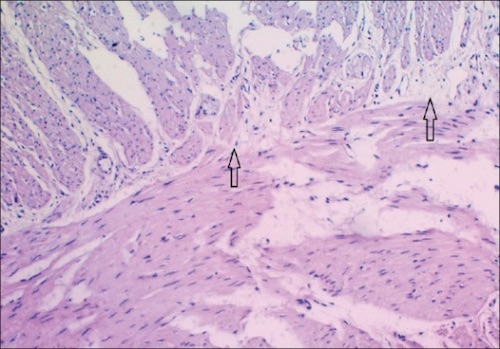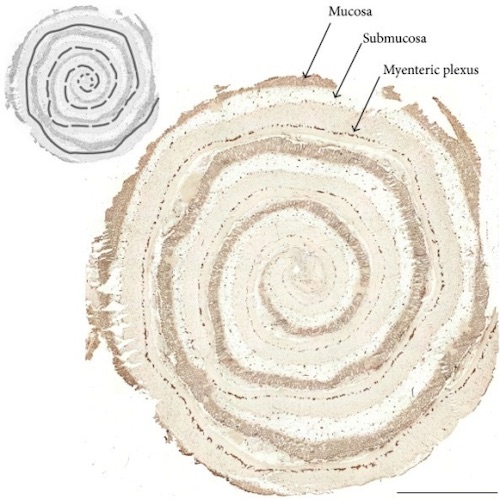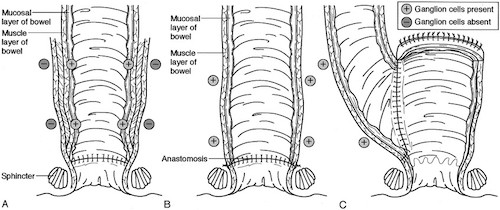Pediatric Surgery: Hirschsprung’s Disease
Hirschsprung’s Disease
Basics
- “Congenital Aganglionic Megacolon”
- Cause: Failure of Neural Crest Cells to Migrate Caudally
- Ganglion Cells That Do Fully Migrate May Fail to Survive or Proliferate
- Most Often Involves the Rectum/Rectosigmoid but Can Involve the Entire Colon or Small Bowel
- Most Common Cause of Colon Obstruction in Peds
- Most Common Gene Mutation: RET
Presentation
- 90% Present in Neonatal Period but May Present Later in Childhood or as Adults
- Symptoms:
- Failure to Pass Meconium
- Abdominal Distention
- Bilious Vomiting
- Feeding Intolerance
- Enterocolitis
- Chronic Constipation
- “Blast Sign” on Anorectal Exam
Hirschsprung’s Associated Enterocolitis (HAEC)
- Functional Obstruction with Stasis Allows Bacterial Overgrowth
- Present in 10% of Children with Hirschsprung’s
- Symptoms: Abdominal Distention, Vomiting, Fever & Diarrhea
- Treatment:
- Stable: Conservative (NPO, Antibiotics & Rectal Irrigations)
- Unstable: Colostomy to Decompress
Diagnosis
- Supportive Radiology:
- Contrast Enema – Demonstrates a Transition Point
- Anorectal Manometry
- Definitive Diagnosis: Rectal Biopsy
- Path: Absent Ganglion in Auerbach/Myenteric Plexus
- Should Be Taken ≥ 1.0-1.5 cm Above the Dentate Line (Normal Paucity of Ganglion Below This Level)
- Type of Biopsy:
- Infants: Suction Biopsy
- Children: Punch or Full-Thickness Biopsy
- Suction Not Deep Enough in Older Children
- Avoid Biopsy in Premature Infants – Wait Until Near-Term Age
- Increased Risk of Complication & Immaturity Causes Difficulty in Recognizing Ganglion Cells
- If No Identifiable Transition Zone or Long-Segment Disease: Consider Laparoscopic Leveling Biopsies to Determine Level of Transition

Hirschsprung Histology: No Myenteric Plexus Between the Two Muscle Layers 1

Hirschsprung Tissue “Swiss-Rolled”, Center is More Distal 2
Treatment
Primary Treatment
- Treatment: Pull-Through Procedure
- Bring Normally Innervated Bowel Down to Anus & Preserve Normal Sphincter Function
- May Need Initial Colostomy
Types of Pull-Throughs
- Swenson Procedure: Resect Entire Aganglionic Colon & End-to-End Anastomosis
- Soave Procedure: Resect Mucosa/Submucosa & Pull-Through Bowel Within a Cuff of Aganglionic Colon
- Duhamel Procedure: Leave Aganglionic Stump & Anastomose Normal Colon Behind the Rectum
- Anterior Aganglionic & Posterior Normally Ganglionic
- Less Pelvic Dissection & Lower Risk of Stricture
Stoma Indications
- Severe Enterocolitis
- Perforation
- Malnutrition
- Massively Dilated Proximal Bowel
Pull-Through Postoperative Changes
- Will Require Daily or Weekly Dilations for a Few Weeks
- Normal Transient Postoperative Changes:
- Increased Stool Frequency
- Perineal Excoriation
- Streaks of Blood in Stool
- Crying with Defecation
- Fecal Soiling
- Very Common
- Causes:
- “Pseudo-Incontinence”
- Severe Constipation with Stool Overflow (Most Common)
- Hyperperistalsis of Pulled-Through Colon
- Abnormal Sensation
- Inability to Feel Rectal Distention
- Loss of Transitional Epithelium Causing Inability to Differentiate Gas from Stool
- Anal Sphincter Damage
- Enterocutaneous Fistula
- “Pseudo-Incontinence”

Pull-Through Procedures; (A) Soave, (B) Swenson, (C) Duhamel 3
References
- Musa ZA, Qasim BJ, Ghazi HF, Al Shaikhly AW. Diagnostic roles of calretinin in hirschsprung disease: A comparison to neuron-specific enolase. Saudi J Gastroenterol. 2017 Jan-Feb;23(1):60-66. doi: 10.4103/1319-3767.199118. (License: CC BY-NC-SA-3.0)
- Nothelfer K, Obermayr F, Belz N, Reinartz E, Bareiss PM, Bühring HJ, Beschorner R, Just L. Expression of the Wnt Receptor Frizzled-4 in the Human Enteric Nervous System of Infants. Stem Cells Int. 2016;2016:9076823. (License: CC BY-4.0)
- Palissei AS, Ahmadwirawan, Faruk M. PalHirschsprung’s disease: epidemiology, diagnosis, and treatment in a retrospective hospital-based study. J Med Sci. Volume 53, Number 2, 2021; 127-134. (License: CC BY-NC-4.0)